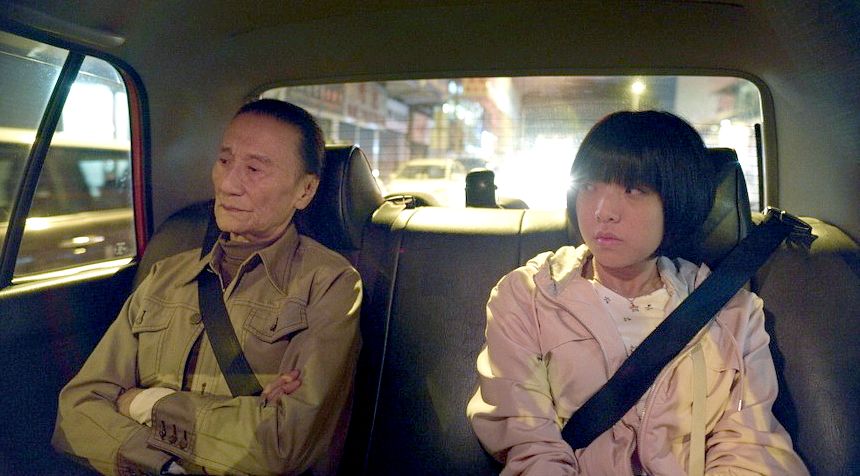Time

The cavern of a theatre hall, lit only by the faint glow of celluloid, exists as a temporal anomaly, separated from the often suffocating hands of time. Genesis, decay and rebirth can occur within a matter of minutes onscreen. The transition from the nigh-tangible grain of film to the smooth sheen of contemporary digital cinematography represents a certain fade in the glamour once associated with moviemaking. The old guard has lost its ground, and it is precisely this nostalgia for a past, lost in damaged film negatives and dusty reels, that Ricky Ko’s Time opens with.
As with much of the 80s Hong Kong cinema that its opening recalls, Time is a film deeply concerned with kinetics. Yet, at the same time, its plot is centred not around flashy action laced with animation like the opening, but with a loss of youth. The elderly trio that forms the emotional core of the film remains tied to the memory that Ko’s debut feature opens with: sleek cars, dashing young men and acrobatic femme fatales. Take the physical mannerisms of Patrick Tse Yin’s protagonist; Yin twirls the blade that defined his youth, trying to mimic the physicality that defines his past. Juxtaposing memories of his wild youth with him being fired from a restaurant for not being fast enough to dice onions is one of the many editing decisions in the film that amplify the melancholy inherent within its performances.
Time isn’t all gloom though; whilst this is very much a film of solemn gestures, its dialogue disrupts the sobriety of its images with juvenile wit. Acting as a foil to Yin’s reluctant assassin, Chung SuetYing embodies the snotty teenager archetype, with her every line acting as a pointed arrow of endearing obnoxiousness that wears down the grumpy emotional barrier of Yin’s old man. The dynamics of age on display occasionally border on parody, but Ko’s strength as a director is in the pathos he extracts. One particular sequence involves Yin being forced to return home at night, due to the demands of policemen who believe that he has dementia. Whilst the tone of such scenes is darkly comedic, they also draw attention to ageism as an endemic ill. The facial closeups to Yin’s weary visage, highlighting how his face pulls into a scowl as a barrier against laughter, act as a particularly effective formal technique, invoking both sympathy and amusement.
Though the script provides plenty of levity double-entendres and snark, it would be amiss to overlook how physicality is utilized by the cast to extract humour. Perhaps the clearest example of this is Lam Suet who is, as always, a joy to watch onscreen. His impotent, chainsmoking former getaway man is a veritable playground for him to exercise his comedic instincts. A recurring element of Suet’s performance is him theatrically heaving post-coitus, and though this is something that would be a throwaway gag in most of his cinematic oeuvre, his delivery of it induces both delight at his Buster Keaton homage, and dread at the thought of Suet falling victim to the hands of time. Suet’s performance would not be nearly as affecting were it not for the chemistry between the triothe pointed slights flung at each other evoke the tension of gangs in a Johnnie To film, yet the often slapstick antics of the trio bring to mind a Stephen Chow comedy. One of the many key plotlines of the film is centred on the trio using their rusty skills as assassins to start a euthanasia-for-hire service. Whilst the increasingly inventive camerawork, such as in a man’s shirt collar turning red after being executed, reflects the absurdity of such an endeavour, the affected performances bring to light the questions of morality (or lack thereof) that prevent our protagonists from leading simple lives.
Cutting the time of others short, Time posits, is a coping mechanism for wrestling with one’s mortality. More than simply a genre exercise or a showcase of performances, Time is a melodrama. The narrative escalates constantly, from chainsmoking in seedy bars to car chases; yet, Ko never loses sight of his characters, whose expressions are highlighted constantly, whether through the warm lighting of lanterns or mirrors. It recalls the unflinching brutality of a Miike action flick, but where victims of killers would simply be collateral, here they are individuals, with lives just as important as those of our protagonists. To deliberate upon all of its narrative turns would be to give away the often surprising abstractions of cinematic form and emotional escalations that form the film, but even without its heartfelt performances and piercing dialogue, Time succeeds in moving the audience through showing not just the movement of a blade across skin, but its aftermath: pools of blood through which we see reflections of our fears.
